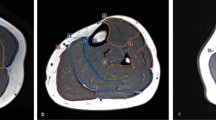Abstract
Objectives
It is necessary to standardize the examination procedure and diagnostic criteria of diffusion tensor imaging (DTI). Thus, the purpose of this study was to examine the reproducibility of measurements using a standardization phantom composed of different fibre materials with different fibre densities (FDs) for the evaluation of fractional anisotropy (FA) derived from DTI.
Materials and methods
Two types of fibre materials wrapped in heat-shrinkable tubes were used as fibre phantoms. We designed fibre phantoms with three different FDs of each fibre material. The standardization phantom was examined using DTI protocol six times a day, and each examination session was repeated once a month for 7 consecutive months. Fibre tracking was performed by setting regions of interest in the FA map, and FA was measured in each fibre phantom. Coefficients of variation (CVs) were used to evaluate the inter-examination reproducibility of FA values. Furthermore, Bland–Altman plots were used to evaluate the intra-operator reproducibility of FA measurements.
Results
All CVs for each fibre phantom were within 2% throughout the 7-month study of repeated DTI sessions. The high intra-operator reproducibility of the FA measurement was confirmed.
Discussion
High reproducibility of measurements using a standardization phantom for the evaluation of FA was achieved.





Similar content being viewed by others
References
Basser PJ, Mattiello J, Le Bihan D (1994) MR diffusion tensor spectroscopy and imaging. Biophys J 66:259–267
Basser PJ (1995) Inferring microstructural features and the physiological state of tissues from diffusion-weighted images. NMR Biomed 8:333–344
Pierpaoli C, Jezzard P, Basser PJ, Barnett A, Chiro GD (1996) Diffusion tensor MR imaging of the human brain. Radiology 201:637–648
Pierpaoli C, Basser PJ (1996) Toward a quantitative assessment of diffusion anisotropy. Magn Reson Med 36:893–906
Basser PJ, Jones DK (2002) Diffusion-tensor MRI: theory, experimental design and data analysis—a technical review. NMR Biomed 15:456–467
Werring DJ, Clark CA, Barker GJ, Thompson AJ, Miller DH (1999) Diffusion tensor imaging of lesions and normal-appearing white matter in multiple sclerosis. Neurology 52:1626–1632
Dong Q, Welsh RC, Chenevert TL et al (2004) Clinical applications of diffusion tensor imaging. J Magn Reson Imaging 19:6–18
Assaf Y, Pasternak O (2008) Diffusion tensor imaging (DTI)-based white matter mapping in brain research: a review. J Mol Neurosci 34:51–61
Poonawalla AH, Zhou XJ (2004) Analytical error propagation in diffusion anisotropy calculations. J Magn Reson Imaging 19:489–498
Ni H, Kavcic V, Zhu T, Ekholm S, Zhong J (2006) Effects of number of diffusion gradient directions on derived diffusion tensor imaging indices in human brain. Am J Neuroradiol 27:1776–1781
Kim SJ, Choi CG, Kim JK et al (2015) Effects of MR parameter changes on the quantification of diffusion anisotropy and apparent diffusion coefficient in diffusion tensor imaging: evaluation using a diffusional anisotropic phantom. Korean J Radiol 16:297–303
Reischauer C, Staempfli P, Jaermann T, Boesiger P (2009) Construction of a temperature-controlled diffusion phantom for quality control of diffusion measurements. J Magn Reson Imaging 29:692–698
Boujraf S, Luypaert R, Eisendrath H, Osteaux M (2001) Echo planar magnetic resonance imaging of anisotropic diffusion in asparagus stems. Magn Reson Mater Phy 13:82–90
Yanasak N, Allison J (2006) Use of capillaries in the construction of an MRI phantom for the assessment of diffusion tensor imaging: demonstration of performance. Magn Reson Imaging 24:1349–1361
Farrher E, Kaffanke J, Celik AA, Stocker T, Grinberg F, Shah NJ (2012) Novel multisection design of anisotropic diffusion phantoms. Magn Reson Imaging 30:518–526
Pullens P, Roebroeck A, Goebel R (2010) Ground truth hardware phantoms for validation of diffusion-weighted MRI applications. J Magn Reson Imaging 32:482–488
Fillard P, Descoteaux M, Goh A et al (2011) Quantitative evaluation of 10 tractography algorithms on a realistic diffusion MR phantom. NeuroImage 56:220–234
Watanabe M, Aoki S, Masutani Y et al (2006) Flexible ex vivo phantoms for validation of diffusion tensor tractography on a clinical scanner. Radiat Med 24:605–609
Fieremans E, De Deene Y, Delputte S et al (2008) Simulation and experimental verification of the diffusion in an anisotropic fiber phantom. J Magn Reson 190:189–199
Trudeau JD, Dixon WT, Hawkins J (1995) The effect of inhomogeneous sample susceptability on measured diffusion anisotropy using NMR imaging. J Magn Reson 108:22–30
Bland JM, Altman DG (1986) Statistical methods for assessing agreement between two methods of clinical measurement. Lancet 1:307–310
Tofts PS, Lloyd D, Clark CA et al (2000) Test liquids for quantitative MRI measurements of self-diffusion coefficient in vivo. Magn Reson Med 43:368–374
Acknowledgements
We thank Mr. Akira Hamano and Mr. Tatsuaki Nakano (TOYOBO CO., LTD., Osaka, Japan) for providing fibre materials.
Author information
Authors and Affiliations
Contributions
Study conception and design: HY. Acquisition of data: MK, HY, RM, KK, and YY. Analysis and interpretation of data: MK, HY, KN, and RM. Drafting of manuscript: MK. Critical revision: HY, TK, KS, and YY.
Corresponding author
Ethics declarations
Conflict of interest
The authors declare that there are no conflicts of interest that may have influenced or imparted bias on the work.
Ethical standards
All procedures in this study were on a phantom only. The editorial does not contain any studies with human participants or animals performed by any of the authors.
Additional information
Publisher's Note
Springer Nature remains neutral with regard to jurisdictional claims in published maps and institutional affiliations.
Rights and permissions
About this article
Cite this article
Kimura, M., Yabuuchi, H., Matsumoto, R. et al. The reproducibility of measurements using a standardization phantom for the evaluation of fractional anisotropy (FA) derived from diffusion tensor imaging (DTI). Magn Reson Mater Phy 33, 293–298 (2020). https://doi.org/10.1007/s10334-019-00776-w
Received:
Revised:
Accepted:
Published:
Issue Date:
DOI: https://doi.org/10.1007/s10334-019-00776-w




